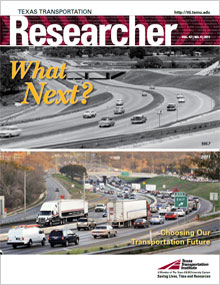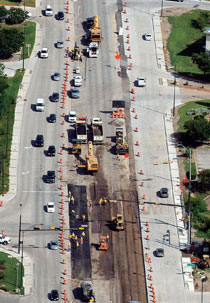Legislative Action Focuses on Highest-Priority Mobility Needs
Traffic congestion problems in Texas are nothing new. What is new is the approach being taken by state leaders in their efforts to address them.
In May, the 82nd Texas Legislature set aside $300 million to “acquire right of way, conduct feasibility studies and project planning, and outsource engineering work for the most congested roads in each of the four most congested regions of the state.” As part of that goal, the Texas Legislature directed Texas Transportation Institute (TTI) to be a facilitator and coordinator of studies designed to:
- determine which projects will offer the greatest results in congestion relief, economic benefits, user costs, safety and pavement quality;
- identify funding options to support the projects and suggest the best use of future revenues for the projects;
- ensure that the best practices in traffic management and demand management are getting the most efficient possible use of the current roadway system;
- ensure open and transparent public participation; and
- make recommendations to the Texas Department of Transportation (TxDOT) at major decision points.
TTI’s Mobility Investment Priorities (MIP) study is designed to get the state’s highest-priority roadway projects moving. Those projects are drawn from TxDOT’s 100 Most Congested Roadways list. The purpose of the study is to complement — but not to replace — efforts already underway by local agencies.
The TTI team conducting the MIP study is led by Senior Research Engineer Tim Lomax and includes co-principal investigator David Ellis, Executive Associate Director Bill Stockton and Senior Research Scientist Cathy Reiley. Local efforts in Austin, Dallas-Fort Worth, Houston and San Antonio are led by experienced researchers in each of the metro areas. Further support is provided by subject matter experts in traffic and demand management, as well as public engagement and communication. The specialty list runs the gamut from signal operations to social media. Shannon Crum of TxDOT’s Transportation Planning and Programming Division is coordinating the MIP effort with a variety of other projects, programs and planning efforts.
“What the legislature has directed us to do involves a different approach to project development,” says Lomax. “That’s because many of the needed projects are so big that they don’t readily fit into the traditional and financially constrained regional planning process. TTI’s work on this study is designed to augment that process.”
The MIP study is one element in a $3 billion appropriation — outlined in Rider 42 of the state budget — that also provides for other mobility needs, bridge improvements, statewide connectivity projects and maintenance, rehabilitation, and safety needs.
“Traditional revenue sources for transportation have been stretched to their limits in recent years,” says Stockton. “And the more severe this funding shortage becomes, the more important it becomes to invest those limited dollars in the most effective way possible. The MIP study is designed to help the state ensure that effectiveness.”

